Zero to Validating a SaaS: A Step-by-Step Recap
Smart entrepreneurs are terrified of risk.
That’s a good thing. In fact, I believe entrepreneurs should actively develop this fear. Nurture it. Use it.
In 2016, I decided to start building a new software product from my company, Audience Ops. This would require a massive investment of money, time, and resources. As a self-funded company, this is not an investment—or a risk—that I take lightly.
Yet, here we are. Product development is underway. This thing is a go.
Over a 6-week period, I went from “just an idea” to a vetted product concept with 14 pre-paid customers, over $3,000 in first revenue, and enough confidence to go forward with this new product—all before I hired a developer to write a single line of code.
Today, I’ll take you step-by-step through each hurdle in the validation process. The most important thing when you’re validating your own product is to understand how your mindset changes the more you mitigate risk. I’ll share how my mindset changed as I went through this process for our new SaaS product.
Now let’s start from the beginning…
Step 1: Is this even possible?
Before I took this “idea” any further, I started by taking a hard look at whether this path is even possible.
Even if I manage to validate this product idea, could the business even afford to invest in building it? Can we sustain that investment all the way through development? What about post-launch? Can we sustain through the long slow ramp up of a customer-base for a new SaaS?
I concluded that the answer is yes, but it will take careful management of cashflow and I better figure out how to acquire customers, fast.
My long-game strategy for Audience Ops, which I laid out in my article, Making Progress, Profitably, is on track. I started this business with the productized done-for-you content service first, which allowed us to grow recurring revenue and profit to a comfortable, sustainable level within 18 months. Now, we’re ready to build out the product line, while treading carefully.
Managing cashflow:
After about 1 year into the business, the productized service had a bit of surplus recurring profit, which I’ve been socking away in a business savings account each month. This is our self-funding source, along with revenue from pre-selling (which I’ll detail below).
Starting off, we have about 3 months worth of development costs saved, and with the current MRR trajectory from the productized service, we should be able to continue to reinvest profits as we go along.
Getting customers:
Building a customer-ready software product will take a lot of time. But then the challenge is acquiring enough customers fast enough to turn it into a viable, sustainable product. That’s never easy.
Thankfully, Audience Ops is not brand new. We’ve established our credibility as a content marketing company and we’ve built an audience in this space. We can—and we will—adjust our marketing plan to serve our new product. It won’t be easy, but at least we can leverage a strong foundation we’ve built already.
My Mindset:
Excited, but…
Far from confident enough to spend much time or money on it yet. Yes, it’s possible, but nothing has been validated yet.
Step 2: Clarify The Vision
Swirling ideas and a mishmash of notes wouldn’t make sense to anyone other than myself (even I don’t understand my own notes from a few weeks ago).
So my next step was to spend about a week creating a first stab of wireframes. These would form a visual concept of what a product like this might look like. They weren’t perfect (in fact, today’s mockups are far different), but they were something tangible. A starting point. Something I can show to others to get feedback.
My Mindset:
Uneasy.
I was spending an awful lot of hours pushing pixels around in Balsamiq without any reassurance that what I was working on would ever bear any fruit. I could be spending this time on actual revenue-generating work, like improving our systems and sales for Audience Ops’ content service. Instead, I’m all alone in my office, designing something that might not ever become a thing.
I have learned to replace the fun of designing wireframes with an appropriate level of uneasiness at this stage.
Any pre-revenue work on a SaaS should come with a healthy dose of uneasiness. Tweet This!
Step 3: Get First Feedback
Having spent a week working on wireframes, I forced myself to stop.
Was I happy with them? Not really. But at a certain point, you just can’t make any more decisions until you can weigh outside feedback.
If I had been working in an office with co-workers, I’d ask a few of them to over to my desk, take a look at what I’m working on, and ask for their opinions. Unfortunately, I work remotely. So I did the next best thing.
I recorded a screencast video walking through this product concept. I sent it to about 30 friends. I wasn’t looking for customers. At this stage, I just want to show it to some friends who I respect as software entrepreneurs and who I knew could give me constructive feedback and wouldn’t hold back criticism.
After a week of gathering responses, I read each one multiple times, I analyzed them as a group, and I jotted down these results:
- Total Replies: 24
- More positive/excited than critical (“you’re onto something”): 20
- Likely customers (“Yes, count me in for the pre-sell group”): 7
- More critical than excited: 3
- Neutral (not much feedback): 1
My Mindset:
A step in the right direction but far from the promised land.
Nobody told me “No, you shouldn’t pursue this.” and I took that as a good sign. Not that I was expecting such a blunt response, but I think if what I was doing was completely off base or didn’t make sense at all, these friends would warn me of that (I would for them). Most of the sentiment I heard was along the lines of “This looks really useful for certain use cases.” The most common criticism I heard “This looks like a really big thing to build” and “You should limit the scope”—which I agreed with.
So this was a good first step, but—and this is a big but—these are friends. Would complete strangers be as receptive to this? Let’s see…
Step 4: Show it to Strangers
My next step was to start validating some of my assumptions with complete strangers. The questions I needed to answer at this stage are:
- Can I actually find people who are actively seeking a tool like this?
- Can I reach them and will they respond?
- Would they be receptive to the idea of using a product like this?
I went to two places to look for people:
Twitter:
I used Twitter Search to find people Tweeting about “content calendar tools”.
Pro tip: use ‘-filter:links’ to exclude any Tweets that contain a link. Why? This limits your search only to people who are asking about content calendar tools or making some sort of comment about them. Otherwise, you’ll see a lot of Tweets simply promoting articles about content calendar tools, which are not as helpful here.
I found about 20 people Tweeting about content calendar tools in the past year (that’s a good sign in itself), so I did some cold @reply outreach to these folks. Most didn’t respond, which is expected. Afterall, I’m a complete stranger and in some cases, their Tweet that I’m replying to is several months old.
But about 4 people replied and were receptive!
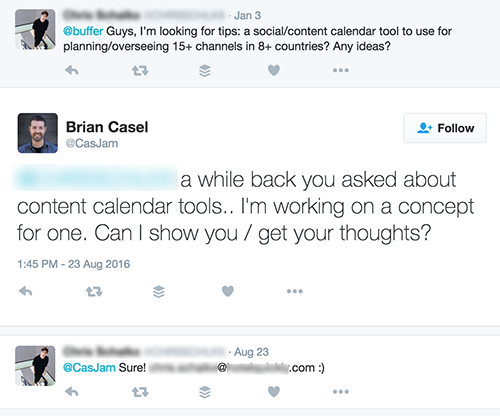
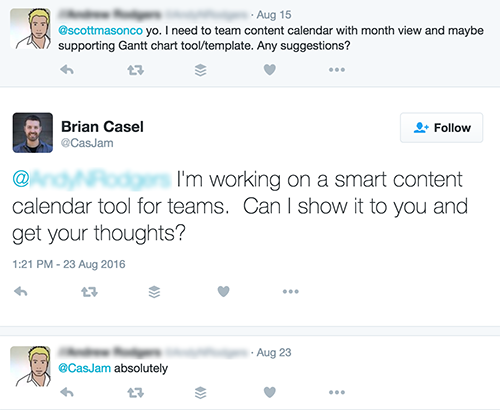
Facebook Groups:
I also joined a bunch of marketing/entrepreneurship groups on Facebook and searched those for conversations about content calendar tools. This required a bit more sifting through comments and replies, but I found several people actively seeking advice on tools in this space.
Again, I did some cold outreach to those folks:

My Mindset:
Encouraged…
Was I able to find channels of people online actively searching for this solution? Yes 🙂
Are these people easy to reach and receptive to talking to me about it? Yes 🙂
These were very encouraging signals. But we’re not there yet…
Step 5: Launch an Explainer Page
So far so good. The early signs are pointing to this being worth at least a bit more time exploring and vetting this idea. So the next logical step will be to start collecting email addresses of people who are interested in this thing. But in order to do that, I’ll need a landing page where I can explain the concept and collect signups.
I used our own Audience Ops Landing Pages plugin to create our initial pre-launch “Explainer Page”. I had the following goals for this page:
- Craft a strong headline/sub-headline that gets straight to the point of what this is and why it’s worth reading on…
- Highlight the 5 key benefits and they solve specific pain points.
- Include an FAQ, which clarifies what this is, and what to expect in terms of pricing, beta, and launch.
As for visuals, I didn’t have finished mockups yet and the wireframes were too rough to show at this point. I needed simple visualizations that support the simple explanations of key benefits. So I watched this Udemy course about using Keynote to create animations. I probably spent too many weekend hours on this, but by Monday I had a few animated gifs to put on the page.
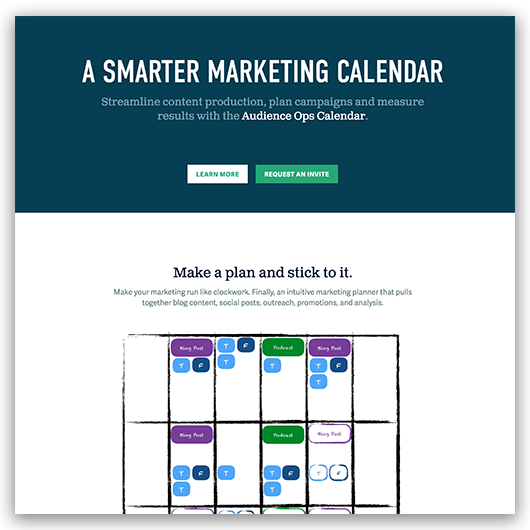
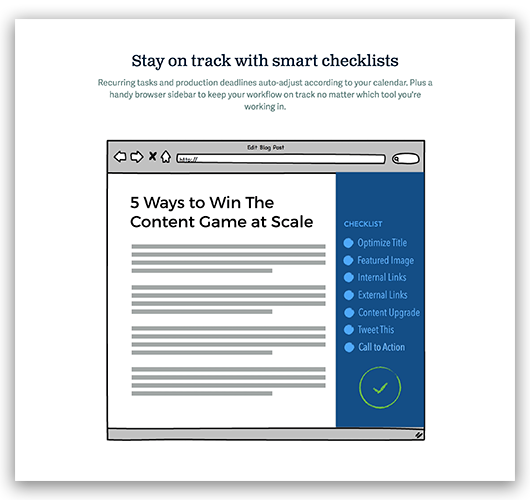
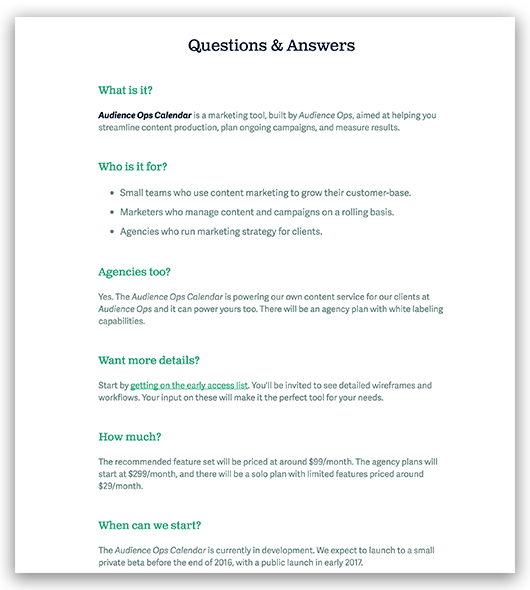
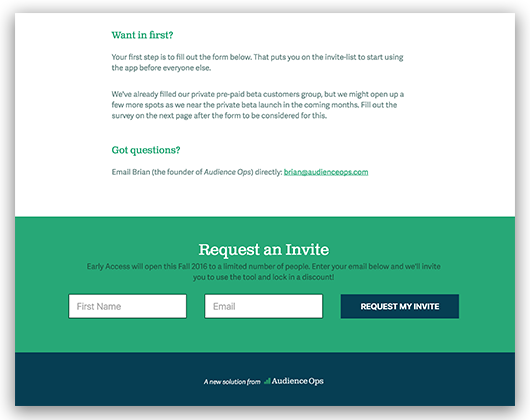
Step 6: Create a Survey
Before I started promoting this page, I needed to be sure that if/when people give me their email address, I’ll be able to learn as much as I can about those people.
So I used Gravity Forms to create a questionnaire containing 11, mostly open-ended questions, like these:
- “How do you think this product will help you?”
- “What are some tools you’ve tried and why have they not stuck for you?”
- “What are your thoughts or questions regarding these pricing options?”
Step 7: Promote the Explainer Page
Now that I have an explainer page ready, with a research questionnaire in place on the back-end, I was ready to start driving traffic to it.
I decided the best place to start was my audience. I sent an email to my list containing a link to this landing page, plus a newly recorded video screencast showing the wireframes. By this point, I revised those quite a bit based on feedback I had been hearing so far.
Only about 150 people entered their email address, which is a good start, but to be honest, I expected a higher percentage of my list to join. But what I did find encouraging was the fact that more than half of them took the time to write lengthy answers to the long questionnaire. That showed me that those who are interested in this product have a lot to say about it and really verbalized the specific pain points well.
My Mindset:
Getting feedback and hungry for more!
There’s nothing more satisfying at this early stage than reading or hearing responses from folks who are carefully evaluating what you’re putting out there. The survey responses I’m collecting have been incredibly helpful for keeping my momentum going on this.
Still, a small list of email addresses and some survey responses aren’t enough to convince me to pull the trigger. Before I invest many thousands of dollars into product development and potentially sink the next year into this thing, I need to know there will be customers willing to pay for this thing.
Step 8: Invite Customers to Pre-Pay
By this point, I’ve had plenty of people see the price points and check a box indicating which one they could see themselves purchasing. But saying you’re going to pay and actually taking out your credit card and paying are two very different things.
I combed through all of the responses to the survey and picked out 15 people who seemed to be the most eager to use the product. I sent personal emails to each of them, inviting them to a 1-on-1 call with me. I told them that on the call I’ll walk them through a presentation about the product and I’ll ask them to pre-pay for access to our ‘inner circle customers’ group.

My Mindset:
Cautious optimism.
By this point, I’ve been as transparent as I possibly could be about the fact that I’ll be asking for payment before actually delivering a useable product. Just about everyone I emailed booked a time for a call. Looking good.
Step 9: Host 1-on-1 Pre-Selling Presentations
As soon as the first few calls were booked, I scrambled to put together a slide deck, which I’d personally present to each person. The presentation consisted of these sections:
-
Description of the target customer
I described 3 overlapping variations (solo business owner, team manager, agency owner) and their pain points. I asked each person if they fit any of these descriptions. Most people fell into 2 of the 3, as expected. -
Key benefits of using the product
Also how these differentiated this product from competitors / similar alternatives. -
Review the current wireframes
A good chance to get (more) feedback and hear first-hand how each person saw themselves using this tool. -
6-month roadmap
I laid out month-by-month the schedule of target milestones, including when we’ll aim to deliver a useable MVP and when we expect to launch to the public. I also shared a breakdown of features, which ones will be in the MVP, and which ones will be come later. -
Inner Circle Group — what included?
I laid out what’s included: Access to the MVP and new features as we build them, a private slack group, monthly group hangout calls, 3 months of post-launch access, plus a substantial lifetime discount. -
Purchase options
I offered 2 options: $200 for single business owners / $500 for agency owners. The difference is agency owners would use it on multiple client sites instead of a single business site. This one-time fee essentially gives each person access to the software from the time we ship the MVP up until mid-2017. After that, they lock in a lifetime discount. Of course, I offered a full refund guarantee at anytime should they decide it’s not a fit.
$200 is not a lot of money for businesses. But I think it’s substantial enough, considering we don’t have a product to give them yet. 14 of the 15 people purchased, 3 of them agencies.
My Mindset:
Reassured and ready to go!
This thing has officially passed “the wallet test” and that gives me the confidence and reassurance I need to move forward. Maybe “obligation” is a better word for it, since at this point I’ve received money from people and we have a delivery schedule that I promised.
Step 10: Form The ‘Inner Circle’ Group
Asking customers to pre-pay isn’t just about gaining validation for a new product. It’s about forming what I call the “Inner Circle” group of beta customers.
This group of 14 make up my key advisors for this product. Who better to take actionable advice from than actual users who’ve invested their own money in order to use the product?
I started a private Slack community where everyone in the group can meet, share advice and compare notes. I regularly post screenshots and updates to this group to show them how the app is coming along. Within just the first 2 weeks the group provided feedback that changed the way the app functions and makes it better. These are insights I could never uncover if I kept design and development behind closed doors.
I also began holding monthly group video calls to give everyone an update and hear face-to-face feedback. I found that gathering feedback together as a group is better than 1-on-1 sessions because they feed off eachother and compare notes from their workflows. It’s easy for me to spot patterns among the group much faster when they all agree in unison.
Step 11: Start Coding
In a way, I have an advantage because I’m non-technical and I wouldn’t have been able to code and build a functional app myself even if I wanted to. That prevented me from jumping the gun and forced me to do this due diligence, research, and validation before spending any money on hiring a developer.
That said, even if you are a developer, I strongly advise you to follow a similar process to what I did before writing any code.
Within a week of closing signups for the Inner Circle group, I hired the developer and began sinking more of my time into planning and designing.
Only 100 Steps to go…
I’m under no illusion that gathering pre-payments from a handful of first customers guarantees this product will work out. Validation isn’t binary. It’s a sliding scale and there are plenty of hurdles remaining.
There are probably 100 or more steps to go between pre-validation and a self-sustaining software product business. From my perspective as the product owner, I see two main responsibilities going forward:
- Oversee product development and ensure we ship this thing on time
- Build our marketing plan and focus on acquiring customers—even before it launches to the public.
That last one is especially important. It goes back to that fear of risk. The risky thing to do would be to stop thinking about customer acquisition and bury myself in product development. The way to mitigate that risk is to do everything I can to acquire customers and build the marketing engine for this product sooner rather than later.
Steal This Process
I hope you’ll follow some variation of the process I laid out. Of course, this process alone won’t guarantee your product will fit your market. It’s always imperative that you’re solving a real problem that customers are willing to pay for. Once you’ve identified that problem, take your time to validate it, vet it, and get that customer feedback early and often.
Mitigating that risk is what keeps you sane through this crazy process.
